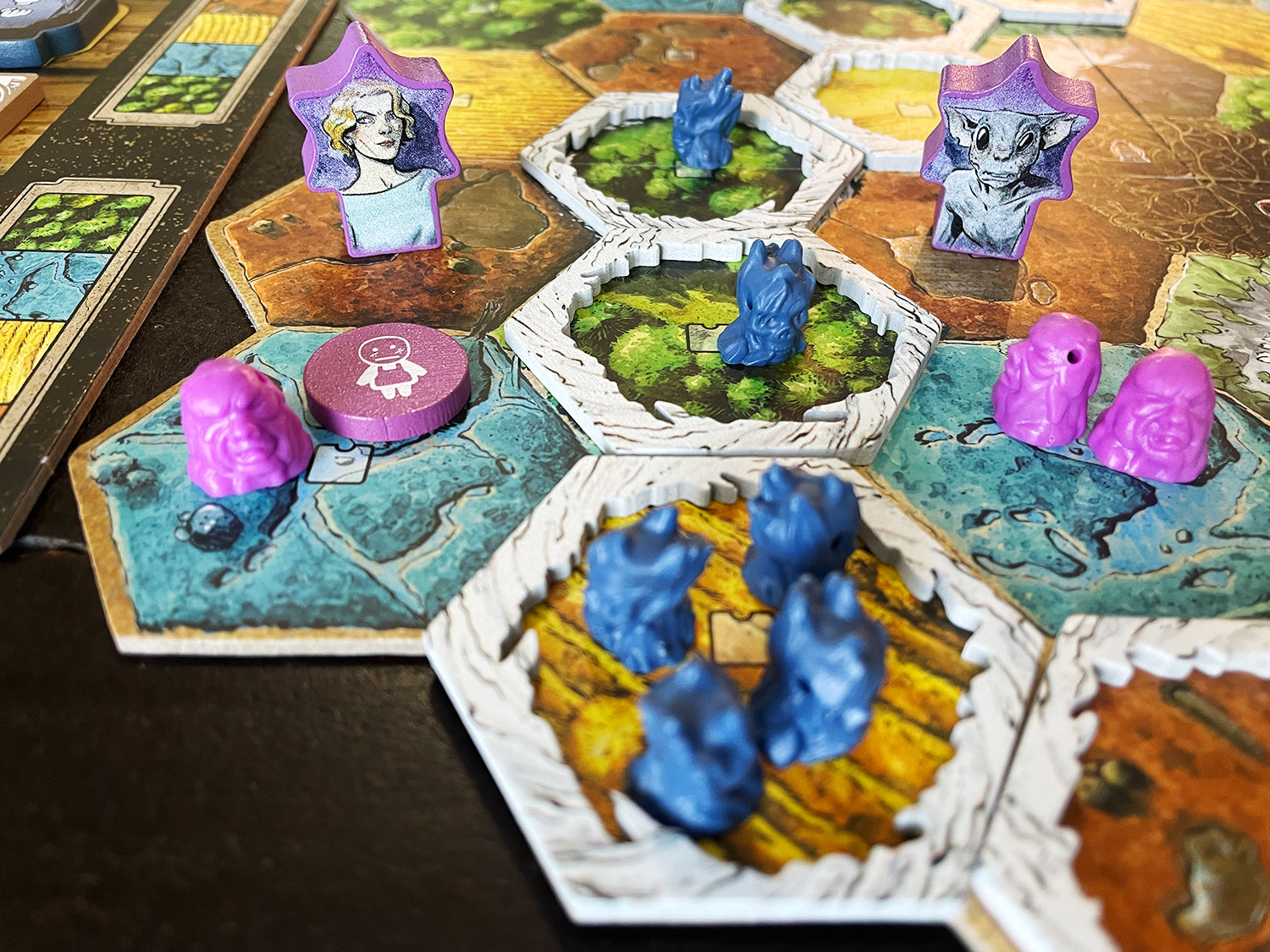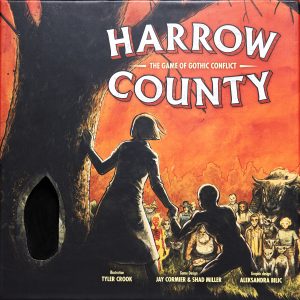 There are legends of darkness and misdeeds in many small villages throughout the land. Has any of us ever driven through an unknown county at night, even during a fierce storm, and not felt unease and a creeping sense of dread? Harrow County taps into these feelings by providing a framework for conflict between rival powers that originates from the hanging of a local witch named Hester.
There are legends of darkness and misdeeds in many small villages throughout the land. Has any of us ever driven through an unknown county at night, even during a fierce storm, and not felt unease and a creeping sense of dread? Harrow County taps into these feelings by providing a framework for conflict between rival powers that originates from the hanging of a local witch named Hester.
Published by Off the Page Games and based on the Dark Horse gothic comic series, it is designed by Jay Cormier and Shad Miller and plays from one to three players in approximately an hour. There’s also an offering hitting shelves now called The Fair Folk Expansion which adds a new faction and the option to play up to four players.
Gameplay Overview:
The main action of Harrow County takes place on a double-sided hex map which features a range of terrain types, including home locations for each faction, mountains, and a central brambles space. Player factions seek specific objectives while battling for area control to be the first to gain seven points. There are three different faction types for head-to-head battles, while the fourth faction is Hester herself. Hester is playable in both solo and three-player games.

Each faction is heavily asymmetrical. The Protectors gain points by saving townsfolk and can use a path ability to trace a route for those townsfolk to flee to safety. The Family is Hester’s kin who have returned to the scene of the crime to destroy the town’s buildings. They have access to a powerful storm effect that limits opponent movement, and they destroy town buildings by tracing the storm’s path from their home space to this objective.
When playing a two-player game, while each side approaches different objectives with different powers, the central action selection is similar. The action board features four mason jars with a printed ability on them mirrored for each faction. Between them are bonus tokens available to the side that activates the corresponding mason jar first. Only three of the four jars are activated each round.
The three main abilities for each faction relate to movement, spawning new pawns (called haints – local spirits who help you achieve your goals), or strengthening fight potential. These abilities are used during certain mason jar actions, as well as through card abilities, and are strengthened over time as players gain ability tokens scattered across the map. The Protectors add these tokens to their board to provide more activations, whereas the Family uses a draw bag to gain them randomly.

Both factions discussed above have several character options to play as and each features their own special ability that can be utilized via a specific mason jar activation. The third faction is the evil twin-sister (Kammi) of one of the Protector characters and she uses a hidden movement mechanism to search for a doll token hidden by another faction. Thematically the Protectors have hidden Kammi’s life essence in the doll, and she wants it back. Kammi uses two legend pawns (only one is used by the other factions) that stay hidden as they search the map. Kammi also has a unique action grid to power her ability tokens.
The main conflict on the map happens when a mason jar battle action is chosen. There is a battleground that features each faction’s strength by way of cubes. Upon activation, a player with the most pawns on their side of the battle adds a cube to those already in the battleground area. Then all cubes in the battleground are dropped into the tree which is a cube tower built into the main box. Whatever emerges from the tree provides the power necessary to defeat opponent haints or damage their legend token.

Defeating haints and successfully attacking legends, completing objectives, and holding the central bramble location at the end of the round, all contribute to points scored by players. Haint points are harder to gain over time as they require more to be defeated for each subsequent point.
Harrow County also features the witch herself, Hester. She can be played in a solo game against two card-driven opponents or as the third player. Hester does not start on the board but rather sends out tree roots to gain influence on the battleground, attempts to influence opponent haints to her bidding, and eventually sparks a bonfire that unleashes her onto the map. Once there, her goal is to take a bite out of a legend’s power before going back into hiding.

Game Experience:
There is a lot happening on the surface of the game system. It only takes a round or two to truly gain a sense of the flow of the game, which is quite easy to grasp, and then designs on strategy can emerge. Unfortunately, the rulebook, prior to July 2024’s recent revision, gets in the way of itself by unfolding elements over a five-chapter span. The new version of the rulebook is vastly superior and recommended as both a learning and reference resource.

This is an excellent two-player area control system. It has a terrific theme with wonderful art from the original comic artist Tyler Crook. Just like Off the Page Games’ previous effort Mind MGMT, everything here reads as an homage to its source. Each legend character provides a new angle. The evil sister Kammi offers new avenues of play. And the mechanisms behind each faction’s actions are fun to experience. Card names such as Doll’s Whisper, Gumption, Psychopomp, and White Bowels add to the setting as well.
Each round players find themselves working out action timing, scrambling to complete their objectives, and supplementing their scores by destroying opponent pawns. There’s not enough time to save everyone and build up a perfect engine here. Each action is a moment of gaining leverage and inching closer to those seven points. I’ve found games at both two and three players to be competitive.
One of the great strengths of Harrow County’s system is its length. After the first play, and upon each play thereafter, the focus tightens and the seven-point threshold for the main three factions becomes easier to grapple with. It makes each session feel lived-in but also just short enough to where players can swap roles or shift things around for a second play. And with the character options available there is a lot of strategy to explore.

On the production side, there is a lot to rave about. However, my favorite inclusion here is also the gimmick: the main box cube tower. THIS is how you do a cube tower—things disappear in this tree, sometimes for the entire game, and it is truly a guessing game as to what is going to show up during a battle. For me, it has a very thematic feel of the witch’s influence over the battleground, as it’s apparent from the first cube drop that she’s out for everyone.
Speaking of Hester, her asymmetric role in a three-player game is also unique. Starting with zero board presence keeps her in the shadows while her attachment to the tree and its roots seeks power to resurrect her. That, coupled with influence over opponent haints, provides a nice foil to the two-player battle, adding some fun nuance and epic moments of emergence—fresh with the burning flames of a bonfire and haint destruction. Hester has a slow build-up that provides creeping tension—a true ticking time bomb.
On the flip side, the solo mode can only be played as Hester and lacks a lot of tension. This is mainly due to the randomness of card draw, though solo players do have a choice in where to place spawns along the way. Regardless, it’s not as engaging of a system on its own, though it does lend itself to being an excellent way to learn how to play the Hester role on its own.
The Fair Folk Expansion:

This small box is the newest addition to this system and adds a fourth player. The Fair Folk expansion explores the depths below the county and provides a new role to intermesh with the other factions. The Fair Folk seek their queen amongst a group of three tokens randomly hidden on the map via an off-board location card. This role provides offerings to other players for hints, adds cubes to the battleground, and has cards that can affect opponent actions. The production is quite elegant, including the silver foil cards and chunky tokens (in the deluxe version).
While the expansion does provide a new way to play and a new layer of asymmetry, I found that what it was trying to do in a four-player game pulled away from tense struggle at lower player counts. It also adds a lot of extra elements that cluttered the map. I do find that the strength of the expansion is increasing player interaction even further, but I don’t imagine I’d use it beyond replacing the Hester role in a three-player game on occasion. I’d recommend the expansion for those seeking a new angle beyond the witch though.
Final Thoughts:
Treat yourself to some gothic horror for this spooky season. Harrow County is an excellent foray into the dark side of small-town life, filled with hidden lore and sinister desires. It features outside threats coming to collect, revenge against past wrongs, and innocents discovering their powers to protect.
I recommend this as a two- or three-player game to immerse your group into over the course of a couple of gaming sessions. Grab a torch. And maybe also a pitchfork. Invite your spirit friends. And get ready to drop some cubes and collectively squeal with glee as the unseen trauma of the past snatches away all your power from within the depths of withering bark and branch. And for those already well into their plays of this game, check out the Fair Folk expansion if you need a new wrinkle to take a break from Hester’s looming presence.
Final Score: 4 stars – Unique theme, tense action selection, wonderful production and art. With plenty of gothic trimmings.
 Hits:
Hits:
• Quality asymmetry
• Tense and fast
• Incredible theming
Misses:
• Original rulebook
• Solo isn’t engaging
• Expansion pulls focus
Source: Board Game Quest





